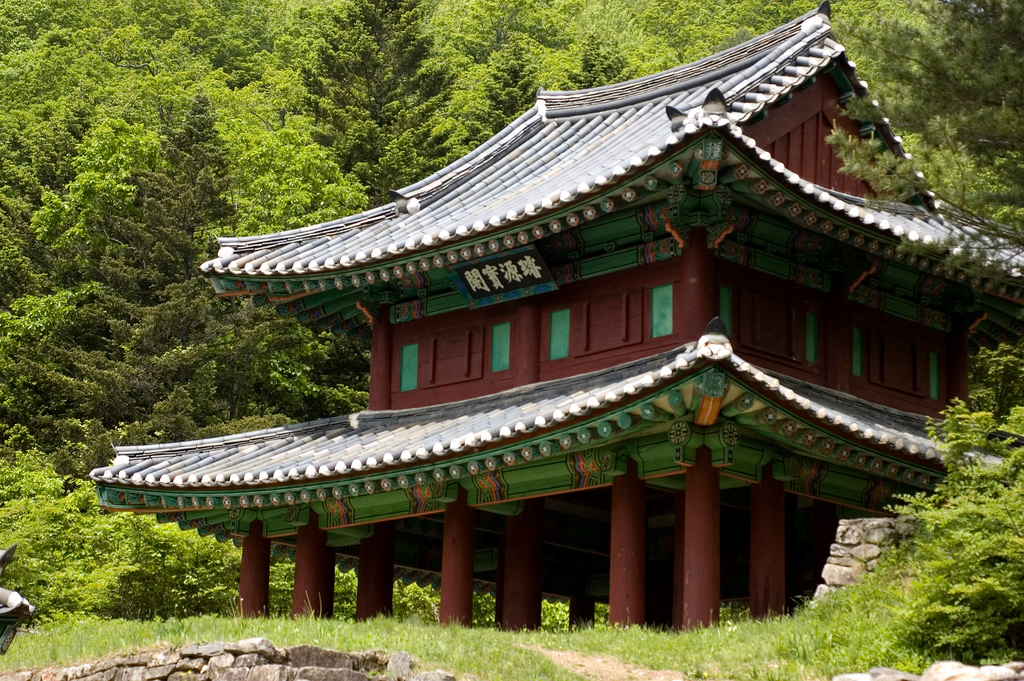
Royal storehouses once held treasure
Story and photos by David McNally
On a mountaintop far from Seoul, this was once a site of great importance to the kings of Korea.
Deep inside Odaesan National Park on Korea’s east coast, these buildings are replicas of wooden structures first constructed in 1606.
Students of Korean history know much today about the daily events of the Joseon Dynasty because of the great care taken by a few concerned historians.
Early in the Joseon period, Korea was subject to many foreign threats. From 1592 to 1598, the Japanese invaded the peninsula and destroyed many irreplaceable Korean antiquities.
There was concern that all would be lost. Historians developed a plan to create hidden mountain repositories for the most important documents of the kingdom. Buddhist monks watched over copies of the “True Record of the Joseon Dynasty,” which were maintained in many locations. The archives span the reigns of 25 Korean monarchs.
The primary archive site was in Seoul. However, for safety the others were kept in special storehouses on far-flung mountains. Today, the national treasure consists of 2,077 volumes of daily chronological records of events from 1392 to 1863.
During the Manchu invasions of 1627 and 1636 the Seoul repository was destroyed. The lost portions of the annals were reprinted from copies at these mountain libraries. The plan worked. The other three sites were Joeongjoksan, Taebaeksan and Jeokseongsan.
Toward the end of the Joseon Dynasty, record keepers started to lose control of the copies. Many documents were burned or lost during the Japanese colonial period from 1910 to 1945 and also during the Korean War from 1950 to 1953.
At present, sources believe the Jeokseongsan copy to be at Kim Il-sung University in North Korea. The 848-volume Taebaeksan copyis stored at a government facility in Busan. The 1,181-volume Jeongjoksan copy, 27 volumes of the Odaesan copy and 21 fragments are kept in the Seoul National University archives.
The wooden Odaesan structures actually survived until the Korean War. But they were burned to the ground and lay in ruin until historical groups sponsored their restoration in 1992.
Odaesan is home to five mountain peaks and as many Buddhist temples. At nearby Woljeongsa Museum, there are early 20th century photographs of the royal storehouses intact. A visit to the site shows the restoration was faithful to the original construction.
Today, the storage site is mysteriously abandoned. A small sign on an Odaesan National Park road points to a smaller dirt road, which leads to the top of the mountain. Hikers virtually have to stumble upon this historical gem. A plaque declares the area as Historic Site No. 37.
Story and photos by David McNally
On a mountaintop far from Seoul, this was once a site of great importance to the kings of Korea.
Deep inside Odaesan National Park on Korea’s east coast, these buildings are replicas of wooden structures first constructed in 1606.
Students of Korean history know much today about the daily events of the Joseon Dynasty because of the great care taken by a few concerned historians.
Early in the Joseon period, Korea was subject to many foreign threats. From 1592 to 1598, the Japanese invaded the peninsula and destroyed many irreplaceable Korean antiquities.
There was concern that all would be lost. Historians developed a plan to create hidden mountain repositories for the most important documents of the kingdom. Buddhist monks watched over copies of the “True Record of the Joseon Dynasty,” which were maintained in many locations. The archives span the reigns of 25 Korean monarchs.
The primary archive site was in Seoul. However, for safety the others were kept in special storehouses on far-flung mountains. Today, the national treasure consists of 2,077 volumes of daily chronological records of events from 1392 to 1863.
During the Manchu invasions of 1627 and 1636 the Seoul repository was destroyed. The lost portions of the annals were reprinted from copies at these mountain libraries. The plan worked. The other three sites were Joeongjoksan, Taebaeksan and Jeokseongsan.
Toward the end of the Joseon Dynasty, record keepers started to lose control of the copies. Many documents were burned or lost during the Japanese colonial period from 1910 to 1945 and also during the Korean War from 1950 to 1953.
At present, sources believe the Jeokseongsan copy to be at Kim Il-sung University in North Korea. The 848-volume Taebaeksan copyis stored at a government facility in Busan. The 1,181-volume Jeongjoksan copy, 27 volumes of the Odaesan copy and 21 fragments are kept in the Seoul National University archives.
The wooden Odaesan structures actually survived until the Korean War. But they were burned to the ground and lay in ruin until historical groups sponsored their restoration in 1992.
Odaesan is home to five mountain peaks and as many Buddhist temples. At nearby Woljeongsa Museum, there are early 20th century photographs of the royal storehouses intact. A visit to the site shows the restoration was faithful to the original construction.
Today, the storage site is mysteriously abandoned. A small sign on an Odaesan National Park road points to a smaller dirt road, which leads to the top of the mountain. Hikers virtually have to stumble upon this historical gem. A plaque declares the area as Historic Site No. 37.
















